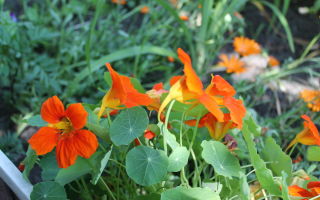Content
- 1 What does it look like
- 2 Chemical composition
- 3 Why is nasturtium useful for humans
- 4 Preparation and application methods
- 5 The use of nasturtium in traditional medicine
- 6 Application in cosmetology
- 7 The use of nasturtium in cooking
- 8 Contraindications to the use of nasturtium
- 9 Collection and procurement
- 10 The benefits of nasturtium for the garden and vegetable garden
- 11 Conclusion
The medicinal properties of nasturtium deserve careful study. A perennial plant can not only decorate the garden, but also help with symptoms of acute and chronic ailments.
What does it look like
Nasturtium is a perennial from the Nasturtium family with a branched and smooth lianate stem up to 2 m in length. The leaves of the plant are elongated, with a solid edge, lobed or palmate and dissected. From June to September, the perennial produces bright orange-red, sometimes yellow or pink flowers in the form of a funnel-shaped tube. In early autumn, it bears fruit - boxes with a single seed inside.
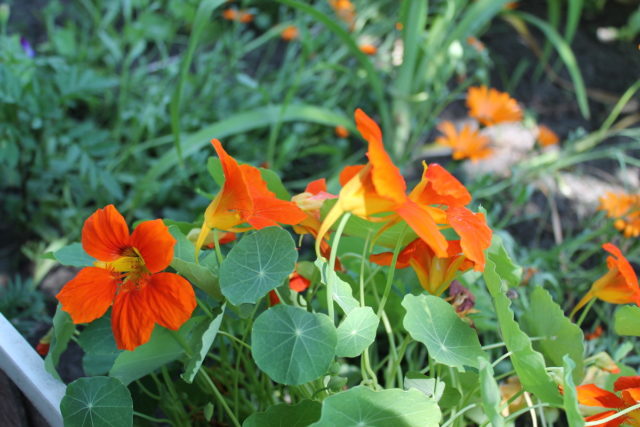
The homeland of nasturtium is South America. But a perennial plant is bred all over the world, mainly in warm climates. Best of all, the capuchin flower takes root in the European part of Russia, the Caucasus and Central Asia.
Chemical composition
The leaves and seeds of nasturtium contain a large amount of nutrients. Among them are:
- essential oils and herbal antibiotics;
- ascorbic acid;
- selenium, iron and iodine;
- carotene;
- potassium, phosphorus and sulfur;
- tropeolin substance;
- vitamins B1 and B2;
- tocopherol;
- saponins and alkaloids;
- isoquercetin;
- anti-cyanogen dyes;
- stearic, erucic and linolenic acids.
Nasturtium has pronounced anti-inflammatory and anti-fungal properties, due to which it is valued in folk medicine.
Why is nasturtium useful for humans
With proper use of nasturtium:
- accelerates metabolism and normalizes metabolic processes;
- stimulates immunity;
- fights inflammation and bacteria;
- helps with otitis media, sinusitis, tonsillitis and rhinitis;
- promotes expectoration when coughing;
- acts as a diuretic and choleretic agent;
- relieves constipation and accelerates digestion;
- relieves inflammation of the lymph nodes;
- improves appetite and lowers cholesterol;
- normalizes blood glucose in diabetes mellitus;
- helps with poisoning and removes toxins from the body;
- helps to get rid of intestinal parasites.
Infusion and decoctions of nasturtium are used as a mild pain reliever. Herbal remedies made from capuchin have a beneficial effect on the nervous system and help with stress and depression.
Why are nasturtium flowers useful?
The medicinal properties of nasturtium flowers in folk medicine are used to treat cardiovascular diseases. According to research results, capuchin buds have a beneficial effect on the body in atherosclerosis, reduce the frequency of angina attacks and eliminate pain.
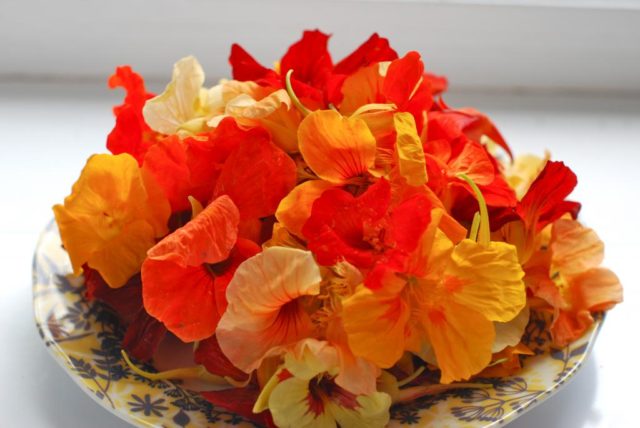
Preparation and application methods
Basically, alcohol and water products based on nasturtium are used for treatment.They are used both internally and externally.
Tincture
For bronchitis, colds, sore throat and thrush in the oral cavity, a strong tincture of capuchin is beneficial. They do it like this:
- dry leaves and flowers of nasturtium are crushed in the volume of a large spoon;
- fall asleep in a glass jar;
- pour 150 ml of vodka;
- for two weeks they are removed in a darkened place.
From time to time, the jar is taken out and shaken. After the expiration date, the capuchin-based product is filtered through cheesecloth.
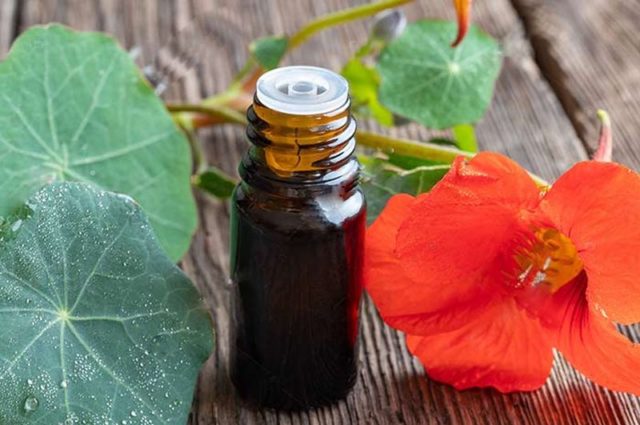
Infusion
For most ailments, an aqueous infusion of the plant has a good effect. You can use it if you are intolerant to alcohol. The medicine helps with sluggish digestion and a tendency to constipation, with respiratory diseases, with joint pain.
The remedy is made as follows:
- leaves and flowers of nasturtium are crushed in an amount of 10 g;
- pour 1 liter of hot water;
- cover with a lid and stand for half an hour;
- passed through cheesecloth.
You need to drink the infusion of nasturtium three times a day, half a glass, it is better to take the drink on an empty stomach.
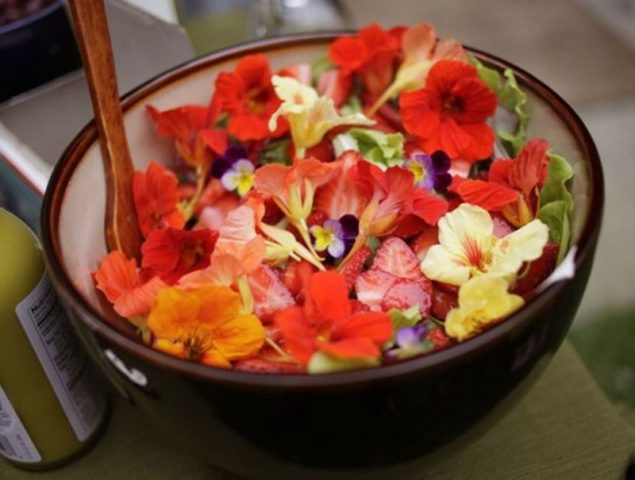
Decoction
For bronchitis, pneumonia and asthma, a concentrated decoction of the plant is beneficial. It is prepared according to the following recipe:
- a large spoonful of dry raw materials is crushed;
- pour 250 ml of boiling water;
- placed in a water bath for 25 minutes;
- removed from the stove and left to cool.
When the product has cooled down, you will need to strain it and add clean water to the initial volume. Drink a decoction of 1/3 cup three times a day.
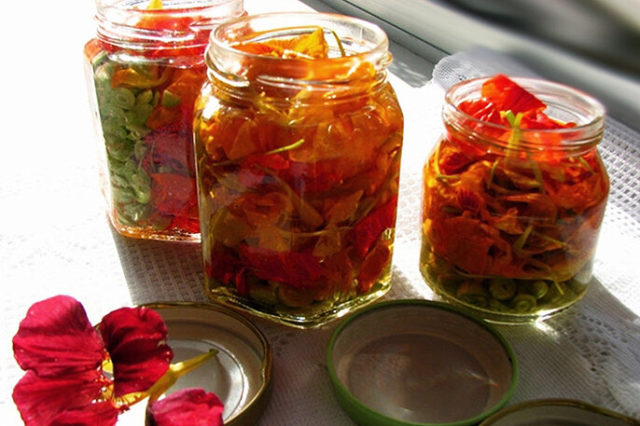
The juice
The beneficial and medicinal properties of nasturtium are concentrated in the juice from the fresh leaves of the plant. To get it, you need to load several plates into a meat grinder or blender and grind into a gruel, and then push through folded gauze to separate the liquid.
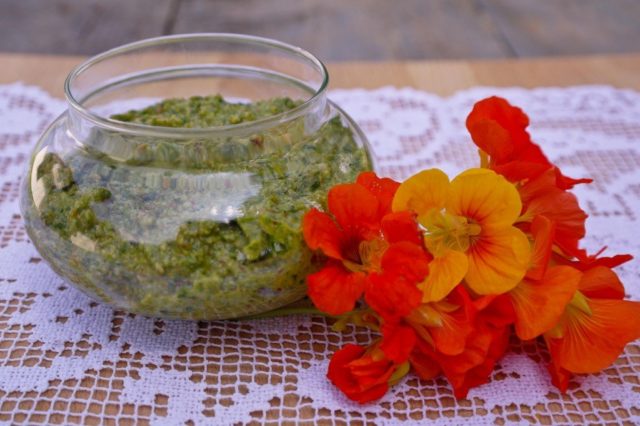
The juice brings benefits for cystitis and urethritis, for anemia and malfunctions of the thyroid gland, for liver diseases and ischemia. Outwardly, it is used for rubbing and lotions for rheumatism, myositis and radiculitis, as well as for treating burns, polyps and warts. When applied to the skin, it may cause a slight burning sensation.
The use of nasturtium in traditional medicine
The medicinal properties of capuchin are used to treat colds, to relieve inflammation and to fight fungi. Traditional medicine offers several proven algorithms.
With a cold
With ARVI and influenza, as well as pneumonia, the following infusion is beneficial:
- a large spoonful of dry leaves is poured into 200 ml of boiling water;
- cover the container with a lid and insist for half an hour;
- passed through folded gauze.
The remedy is taken in 1/3 cup three times a day. You can also use nasturtium infusion for bronchial asthma to reduce the frequency of attacks.
From cough
For colds and chronic coughs, an alcoholic tincture of capuchin gives a beneficial effect. Do it as follows:
- two large tablespoons of dry nasturtium herb pour 250 ml of vodka;
- clog the container and put it in a dark and warm place for two weeks;
- shake periodically, and filter after the expiration date.
You need to take the medicine three times a day, a single dosage is 25 drops. The therapy is continued for two weeks, then they take a break and repeat the course.
With kidney stones
For kidney stones, you can use an aqueous decoction of nasturtium. It is prepared according to this recipe:
- a large spoonful of buds and leaves of capuchin is poured with 500 ml of boiling water;
- kept in a water bath for 15 minutes;
- removed from the stove and insisted under the lid for another 40 minutes;
- filter from sediment.
You need to drink 100 ml three times a day on an empty stomach.
With angina and stomatitis
For inflammatory processes in the throat and oral cavity, medicinal gargles can be used. It is necessary to prepare such a remedy:
- 15 g of dry grass and flowers are poured with a glass of boiling water;
- keep on low heat for 20 minutes;
- filter and cool slightly;
- add a small spoonful of honey to the broth and stir.
Gargle the throat and mouth with a warm drink up to five times a day.
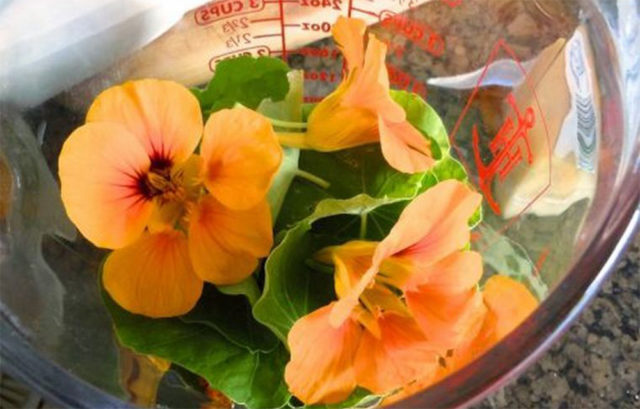
To improve potency
When libido is weakened in men, the following nasturtium-based remedy is beneficial:
- 50 g of dried capuchin flowers are mixed with an equal amount of ordinary wormwood;
- add 50 g of purple aster flowers;
- measure 100 g of the mixture and pour in 1 liter of sweet cahors;
- insist in a dark place for three weeks.
The contents of the container must be shaken every day. When the nasturtium medicine is ready, it will need to be filtered and poured into a new jar. Take 50 ml of the product shortly before bedtime, it is allowed to dilute the tincture with a small amount of water.
With candidiasis
With thrush in the mouth, the medicinal properties of nasturtium and other herbs help. Healing collection is done like this:
- sage and rose petals are mixed in equal volumes of 4 large spoons;
- add 3 large spoons of nasturtium flowers;
- pour the collection of 15 ml of vinegar;
- measure out a large spoonful of the mixture and stir it in 300 ml of boiling water.
Insist the product under the lid until it cools. After that, the nasturtium drink is strained and used to rinse the mouth and throat up to eight times a day.
With osteoporosis
The infusion of medicinal nasturtium has a good effect on joint diseases. Traditional medicine recommends the following recipe:
- 30 g of dry capuchin leaves are poured into 1 liter of hot water;
- cover the container with a lid and wrap it with a towel for 10 minutes;
- filter the infusion through cheesecloth.
You need to take a nasturtium remedy three times a day, 150 ml.
Application in cosmetology
The beneficial properties of nasturtium are used in home cosmetology. Decoctions and infusions based on the plant slow down the aging of the skin and regulate its oiliness, strengthen hair and prevent hair loss.
With weakened, dull and brittle curls, this remedy is beneficial:
- leaves, buds and seeds of nasturtium are mixed in equal quantities;
- measure out 30 g of raw materials;
- pour 1 liter of hot liquid;
- simmer in a water bath for about 15 minutes;
- insist under the lid for another 45 minutes.
The finished product is filtered and diluted with clean water to the initial volume. A decoction of nasturtium should be rubbed into the scalp 3-4 times a week. With regular use, it will improve the nutrition of the hair follicles and activate the growth of curls.
You can use nasturtium for facial skin care. At the first signs of wilting, such a mask will bring a good effect:
- the capuchin flower is crushed and combined with egg yolk;
- add a large spoonful of sour cream;
- mix the ingredients.
The mixture is spread over the face for ten minutes, after which it is removed with a damp cotton swab and washed with cool water.
The use of nasturtium in cooking
The plant is popular not only in medicine, it is actively used in the kitchen. In South America, unripe seeds, young buds and fresh leaves of nasturtium are considered a spice - all parts of the capuchin emit a specific pleasant aroma. In Europe, perennials are used in the preparation of salads and vitamin drinks, meat dishes are seasoned with seeds and flower buds. Nasturtium is added to marinades, and vinegar is made from the flowers. Dried capuchin buds are added to homemade wines, tinctures and teas.
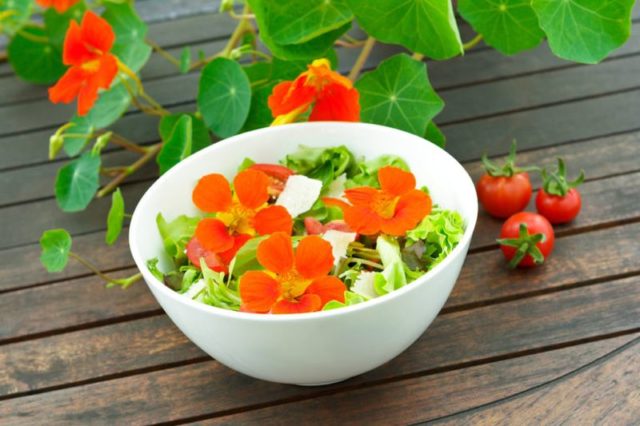
Contraindications to the use of nasturtium
The health benefits and harms of nasturtium are related to each other. First of all, you need to use medicinal raw materials strictly in the dosages indicated in the recipes. If the volume is exceeded, the capuchin will irritate the stomach and intestines, leading to heartburn and pain.
It is necessary to refuse to use medicinal raw materials of nasturtium:
- with an ulcer and gastritis in a state of exacerbation;
- with individual allergies;
- with pancreatitis;
- with inflammatory processes in the kidneys.
It is not recommended to use nasturtium-based products during pregnancy and lactation. Also, natural preparations are not offered to children and adolescents under 18 years of age.
Collection and procurement
You can harvest the leaves, buds and buds of nasturtium throughout the summer. But it is best to do this in June, when the capuchin is just beginning to bloom.
Medicinal raw materials are dried in the fresh air or in an oven at a temperature of 40 ° C. You need to store the blanks in a dark place in paper bags or glass containers. It is also permissible to freeze fresh leaves and buds, in which case they will retain all the useful properties.
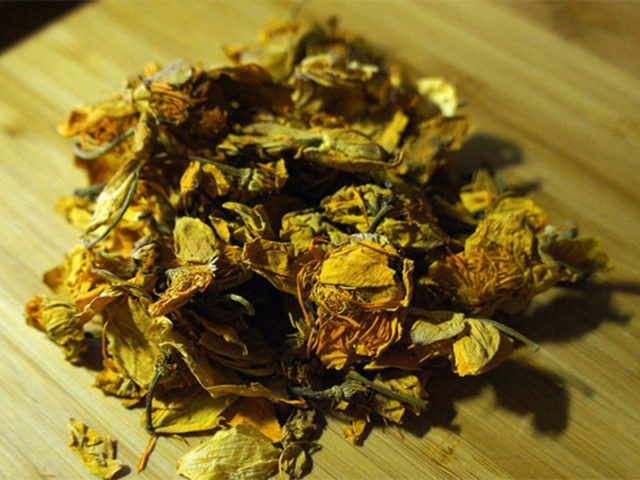
The benefits of nasturtium for the garden and vegetable garden
Nasturtium not only decorates the garden area, but also helps to rid it of pests. The smell of the plant scares off cabbage and whitefly, so you can plant capuchin near potatoes, cabbage, cucumbers and tomatoes.
Nasturtium roots secrete phytoncides that disinfect the soil. For this reason, the flower is often used as an element of crop rotation. When planted next to fruit trees, the capuchin promotes good pollination, as it attracts beneficial insects to the garden.
Conclusion
The medicinal properties of nasturtium are very diverse - the plant is used to treat colds, intestinal and inflammatory ailments. Capuchin helps take care of the skin and hair, improves the taste of culinary dishes, although it requires caution when using.

